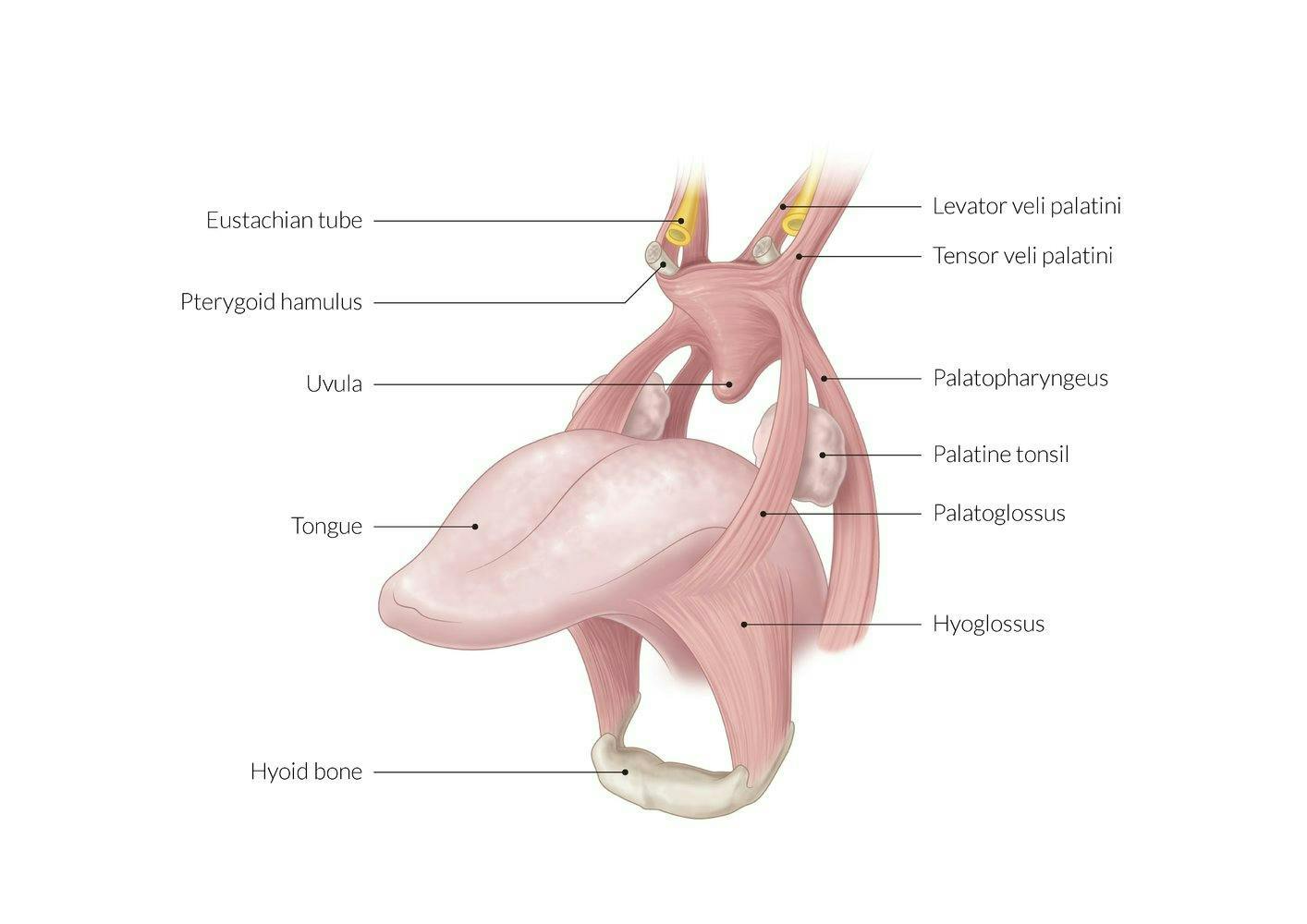Uvula
Published: Jul 18, 2023
/
Updated: Aug 4, 2023
Written by Oseh Mathias
Founder, SpeechFit
The uvula is a small, cone-shaped protrusion hanging down at the back of the soft palate in the human mouth. It's derived from the Latin word 'uva', meaning 'grape', due to its grape-like shape.

Anatomically, the uvula is composed of connective tissues, including some muscle tissue, serous and mucous glands, and a highly vascular layer of pseudostratified ciliated columnar epithelium[2]. The muscle found within the uvula is the musculus uvulae, which forms part of the soft palate and aids in speech and swallowing[3].

The uvula is positioned at the rear of the oral cavity, extending from the posterior edge of the soft palate. It's situated above the back of the tongue and just in front of the pharynx[2]. It's often easily seen and touched when one opens the mouth wide.
The uvula serves several important functions. Its primary roles include:
Speech: The uvula plays a crucial role in articulation, especially in the phonation of certain sounds. It works in conjunction with the back of the throat, the palate, and the air coming up from the lungs to produce a range of sounds. This is particularly important for languages with uvular consonants, like French and Arabic[4].
Swallowing and Digestion: When you swallow, the uvula and the soft palate move together to block the passage to the nasal cavity, directing food and drink down towards the esophagus and away from the nose. This process is called the velopharyngeal closure[5].
Saliva Production: The uvula contains a large number of serous and mucous glands, which contribute to the production of saliva. This moistens the mouth and helps in digestion[6].
Immune Response: The uvula is part of the body's immune system. It helps prevent microorganisms from entering the body, along with tonsils and other lymphoid tissues in the throat. The uvula's movement during swallowing also helps to clear out mucus and pathogens from the nasal part of the pharynx[7].
The uvula is innervated by the vagus nerve (cranial nerve X), specifically through its pharyngeal branch[8].
The vagus nerve is primarily responsible for the sensory innervation, such as providing the sensation of touch and pain, while the pharyngeal plexus, which is made up of fibers from the vagus nerve and the glossopharyngeal nerve (cranial nerve IX), provides motor innervation, controlling the movements of the uvula[2].
The lesser palatine nerve, a branch of the maxillary nerve (which is a branch of the trigeminal nerve, cranial nerve V), also provides sensory innervation to the uvula, including the sense of taste[10].
Problems with the uvula, like a too long or swollen uvula (uvulitis), can lead to issues with speech, swallowing, and sleep (e.g., snoring, sleep apnea)[11].
Oseh is a software engineer, entrepreneur and founder of SpeechFit. Oseh is passionate about improving health and wellbeing outcomes for neurodiverse people and healthcare providers alike.
References
AMBOSS. (2023). [Image of the oral cavity]. AMBOSS Knowledge. https://www.amboss.com/us/knowledge/oral-cavity
Moore, K. L., Dalley, A. F., & Agur, A. M. R. (2018). Clinically oriented anatomy. Wolters Kluwer.
Drake, R. L., Vogl, W., & Mitchell, A. W. M. (2019). Gray's anatomy for students. Elsevier.
Catford, J. C. (1988). A practical introduction to phonetics. Clarendon Press.
Logemann, J. A. (1998). Evaluation and treatment of swallowing disorders. Pro-ed.
Proctor, G. B., & Carpenter, G. H. (2007). Regulation of salivary gland function by autonomic nerves. Autonomic Neuroscience, 133(1), 3-18.
Brandtzaeg, P. (2007). Induction of secretory immunity and memory at mucosal surfaces. Vaccine, 25(30), 5467-5484.
Ropper, A. H., & Samuels, M. A. (2009). Adams and Victor's Principles of Neurology (9th ed.). McGraw-Hill.
Mu, L., Chen, J., Li, J., Fowkes, M., Benson, B., Nyirenda, T., Sobotka, S., Christopherson, M., & Sanders, I. (2020). Innervation of human soft palate muscles. The Anatomical Record. https://doi.org/10.1002/ar.24531
Standring, S. (Ed.). (2020). Gray's Anatomy: The Anatomical Basis of Clinical Practice (42nd ed.). Elsevier. ISBN: 9780702077050.
Sateia, M. J. (2014). International classification of sleep disorders. Chest, 146(5), 1387-1394.
